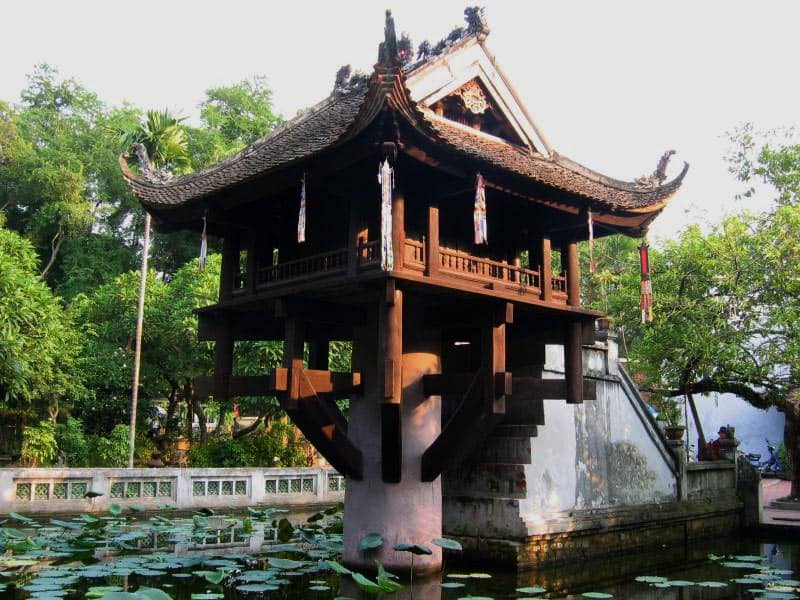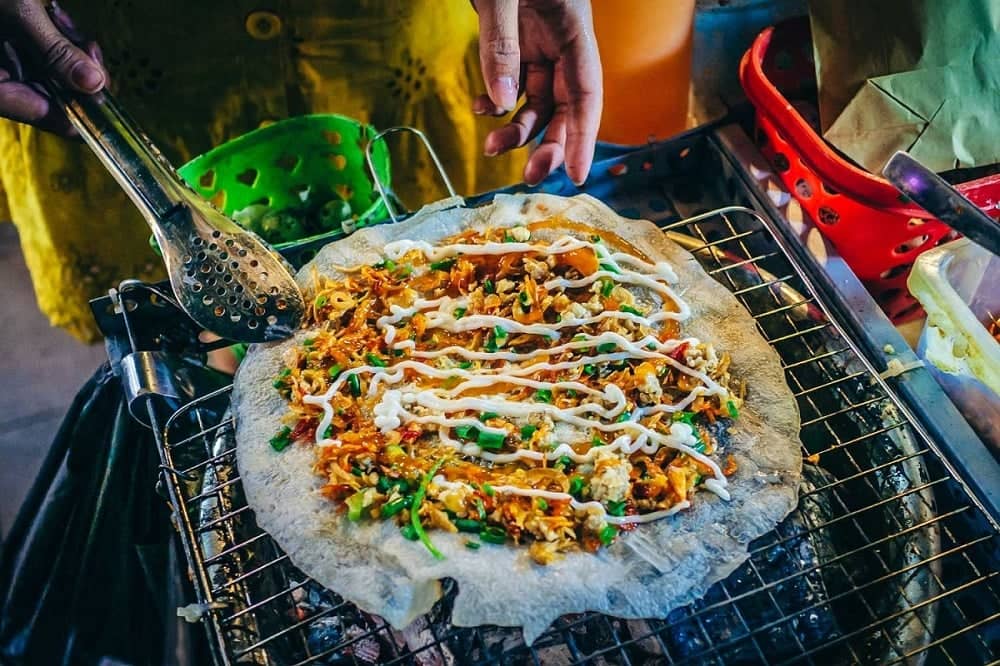
Simple beauty in Hanoi Old Quarter
Experience the charm of Hanoi Old Quarter, a must-visit destination brimming with history and culture. Wander through its bustling streets, savor authentic street food, visit landmarks such as the Dong Xuan Market and the ancient Bach Ma Temple, and shop for traditional crafts. Discover the best places to stay and tips for a memorable visit to Hanoi‘s historic heart.
I. Introduction to Hanoi Old Quarter
1. Overview of Hanoi Old Quarter

The Old Quarter attracts all tourists
The Hanoi Old Quarter is a must-visit destination for any traveler seeking to immerse themselves in the rich history and vibrant culture of the city. This historic neighborhood, with its labyrinthine streets and centuries-old architecture, offers a unique glimpse into the soul of Hanoi. Here, the past and present blend seamlessly, creating a lively and dynamic atmosphere that captivates visitors from around the world.
The Hanoi Old Quarter is not just a place to see; it’s a place to experience. Walking through its narrow alleyways, you can feel the echoes of history in the ancient buildings, many of which have been preserved for hundreds of years.
2. The Appeal of Hanoi Old Quarter
What makes the Hanoi Old Quarter truly unmissable is its vibrant street life. From early in the morning until late at night, the streets are alive with activity.

Visitors can easily see images of street vendors
Street vendors sell fresh produce and handmade goods, while motorbikes weave through the crowds and the aroma of street food fills the air. This area is also home to numerous cultural and historical sites, including ancient temples, pagodas, and colonial-era buildings that tell the story of Hanoi’s diverse past.
Whether you’re a history buff, a foodie, a shopaholic, or simply an adventurous traveler, the Old Quarter offers something for everyone. The blend of traditional and modern, the local and the cosmopolitan, creates an unforgettable experience that captures the essence of Hanoi.
II. History of Hanoi Old Quarter
1. History of the formation of Hanoi Old Quarter
The Hanoi Old Quarter, often referred to as the “36 Streets,” dates back to the 11th century during the Ly and Tran dynasties. This area originally developed as a bustling trading hub due to its proximity to the Red River and the ancient citadel of Thang Long, which served as the political and economic center of Vietnam.
Over centuries, the Old Quarter expanded and evolved, particularly during the Le Dynasty (1428–1799), when Hanoi flourished as a vital commercial center, attracting traders from all over Asia.
The French colonial period in the late 19th and early 20th centuries further influenced its urban development, introducing European architectural elements while retaining its traditional Vietnamese charm.
2. Ancient Architecture
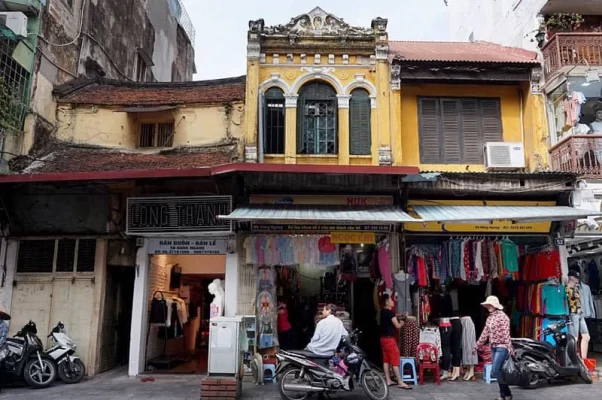
Houses with ancient French-style architecture
The architectural style of the Hanoi Old Quarter is a unique blend of Vietnamese, Chinese, and French influences, creating a distinctive and charming aesthetic.
The most notable feature is the “tube houses”, characterized by their narrow and elongated structure, typically only a few meters wide but extending deep into the block. Tube houses often feature a multi-story layout with open courtyards to allow light and ventilation.
Additionally, French colonial architecture is evident in various buildings, adding a layer of historical complexity to the quarter’s streetscape.
3. The Importance of the Old Quarter
The Hanoi Old Quarter has always been a vital economic and cultural hub, playing a significant role in the city’s history. In the past, it was a center for artisans and merchants, with each street dedicated to a specific trade or craft, such as silk, silver, or medicine.
These streets were often named after the goods sold there, a tradition that continues to this day. The Old Quarter’s strategic location and vibrant trade activities contributed significantly to Hanoi’s growth and prosperity.
In modern times, the Hanoi Old Quarter remains a bustling area, retaining its historical significance and continuing to attract visitors from around the world. It serves as a living museum, preserving the traditional way of life and architecture amidst the rapid urbanization of Hanoi.
III. Outstanding Attractions in Hanoi Old Quarter
1. Dong Xuan Market

Dong Xuan Market is the largest local market in the Old Quarter
Dong Xuan Market, established in 1889, is one of Hanoi’s largest and oldest markets. This bustling market, located in the heart of the Old Quarter, has become a symbol of the city’s commercial vibrancy.
Today, Dong Xuan Market remains a hub for both locals and tourists seeking a wide array of products. Visitors can find everything from fresh produce, dried goods, and seafood to clothing, accessories, and souvenirs.
The market is particularly renowned for its affordable prices and variety of traditional Vietnamese items, making it a must-visit spot for those wanting to experience the local culture and shopping scene.
2. Bach Ma Temple

Bach Ma Temple is one of the four most sacred temples in Hanoi
Bach Ma Temple, or the White Horse Temple, is one of the oldest temples in Hanoi, dating back to the 11th century. This sacred site is dedicated to the White Horse, which is believed to have guided King Ly Thai To in determining the location for the city’s ancient citadel.
The temple’s architecture is a stunning example of traditional Vietnamese design, featuring intricate carvings, beautiful courtyards, and serene altars.
Visitors can explore the temple’s rich history and cultural significance, learning about the legends and spiritual beliefs that have shaped Hanoi over the centuries. Bach Ma Temple stands as a testament to the city’s deep-rooted religious traditions and its historical heritage.
Click here: Hanoi Day Trip
3. Ma May Ancient House
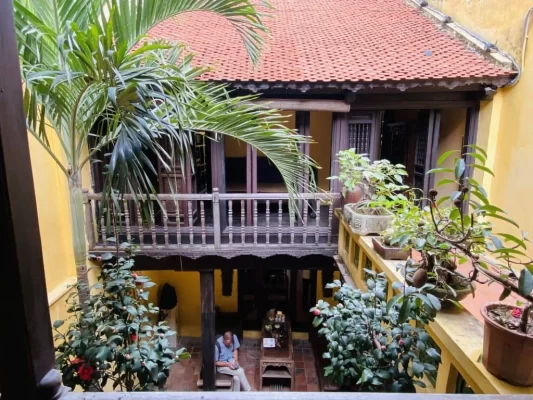
Ma May Ancient House
Ma May Ancient House, located at 87 Ma May Street, is a well-preserved example of a traditional Vietnamese tube house. Built in the late 19th century, this historic house offers a glimpse into the architectural style and daily life of Hanoi’s residents during that era.
The house features a narrow facade but extends deep into the block, with multiple courtyards that provide natural light and ventilation. Inside, visitors can admire the original wooden furniture, decorative artifacts, and traditional layout, all of which reflect the cultural heritage and lifestyle of Hanoi’s past.
Ma May Ancient House is a fascinating destination for those interested in history, architecture, and Vietnamese folk culture.
4. O Quan Chuong – The Last Remaining Ancient Gate
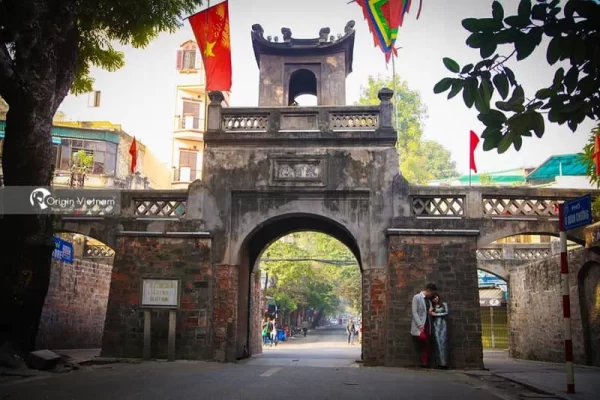
O Quan Chuong
O Quan Chuong is the only surviving gate of the original Thang Long citadel, which once had 21 gates. Built in 1749 during the Later Le Dynasty, this historical structure has withstood the test of time and various conflicts.
O Quan Chuong is named after a high-ranking mandarin who defended the gate during the French invasion. The gate’s architecture is a blend of traditional Vietnamese and ancient Chinese styles, with its arched doorway and sturdy construction.
Today, O Quan Chuong stands as a symbol of Hanoi’s resilience and historical continuity, offering visitors a tangible connection to the city’s ancient past.
5. Hanoi Train Street

Hanoi Train Street
One of the most unique attractions in Hanoi Old Quarter is Hanoi Train Street, where a railway track runs through a narrow residential street. Several times a day, a train passes through, just inches away from the houses.
Visitors can sit at one of the many small cafes lining the track, enjoying a coffee while waiting for the train to come by. It’s a thrilling and photogenic experience, but it’s important to follow safety guidelines and be respectful of the residents.
Click here: Best Coffee Shops in Hanoi That You Must Try ASAP
IV. Cultural and Culinary Experiences
1. Street Food Delights

You definitely have to try Bun Cha once
Hanoi’s Old Quarter is a culinary paradise for street food enthusiasts. The narrow streets are lined with vendors selling a variety of delicious and affordable dishes. Here are some must-try Hanoi street foods:
- Phở: This iconic Vietnamese noodle soup is a must-try when visiting Hanoi. Typically made with beef or chicken, the broth is simmered for hours to create a rich, savory flavor. You’ll find many street vendors and small shops serving phở, each with their own unique twist on the recipe.
- Bún Chả: A Hanoi specialty, bún chả consists of grilled pork patties and slices served with vermicelli noodles, fresh herbs, and a tangy dipping sauce. Often accompanied by spring rolls, this dish is a delightful mix of flavors and textures.
- Bánh Mì: The Vietnamese sandwich, bánh mì, combines French baguette with various fillings such as pate, cold cuts, pickled vegetables, and fresh herbs. It’s a quick and tasty option for a meal on the go.
Click here: Hanoi Cuisine
2. Traditional Coffee Culture

You can only find Egg Coffee in Hanoi
Hanoi is famous for its unique coffee culture, and the Old Quarter is the perfect place to experience it. There are several coffee drinks that you shouldn’t miss:
- Egg Coffee: A Hanoi original, egg coffee is made by whipping egg yolk with sugar and condensed milk until it becomes frothy and creamy, then adding it to hot or iced coffee. The result is a rich, custard-like coffee that is both sweet and strong.
- Black Coffee: For those who prefer their coffee strong and simple, Hanoi’s black coffee is a must. Made with robusta beans, it has a bold flavor that is often enjoyed with a touch of sugar.
Click here: Private Street Food Tour Hanoi by Walking in 3 Hours
3. Water Puppet Show
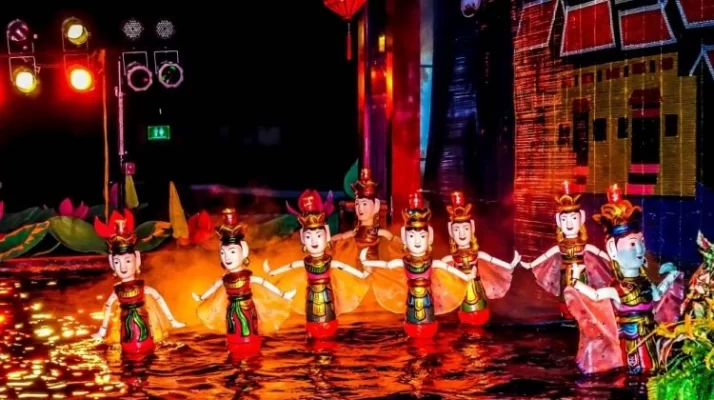
Water Puppet Show
The Thang Long Water Puppet Theatre, located near Hoan Kiem Lake, is renowned for its unique and captivating water puppet shows. This traditional Vietnamese art form dates back over a thousand years, originating from the Red River Delta region.
The performances take place in a pool of water, with puppeteers standing behind a screen and manipulating the wooden puppets using long bamboo rods and strings. The shows depict scenes from rural life, historical legends, and folk tales, accompanied by live traditional music played on authentic Vietnamese instruments.
Attending a water puppet show at Thang Long Water Puppet Theatre provides an enchanting cultural experience, allowing visitors to immerse themselves in the rich artistic heritage of Vietnam.
Read more: Hanoi Culture
4. Festivals and Events

Mid-Autumn Festival in Hanoi
Hanoi Old Quarter is not just about food and coffee; it is also a vibrant cultural hub with various festivals and events throughout the year.
- Mid-Autumn Festival: This festival is celebrated with colorful lanterns, lion dances, and mooncakes. The Old Quarter becomes particularly lively with street performances and stalls selling festival-related goods.
- Lunar New Year: The most significant festival in Vietnam, Lunar New Year is marked by traditional music, dance performances, and elaborate decorations. The streets of the Old Quarter are adorned with red and gold, and there are many cultural activities to enjoy.
- International Hanoi Street Food Festival: Held annually, this festival showcases a wide variety of street foods from Hanoi and other parts of Vietnam. It’s an excellent opportunity to sample different dishes and enjoy live cooking demonstrations.
V. Shopping at Hanoi Old Quarter
1. What to Buy in Hanoi Old Quarter
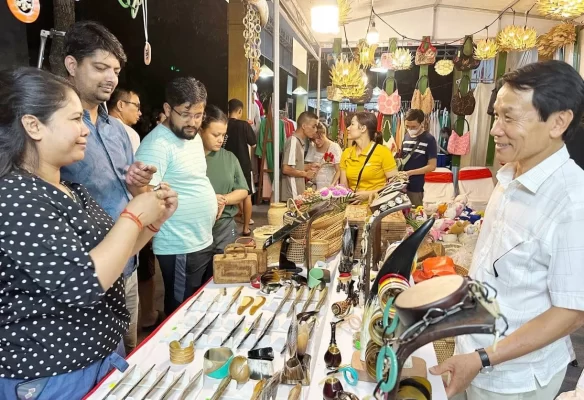
You can find countless unique souvenirs in the Old Quarter
Hanoi Old Quarter is a treasure trove of traditional handicrafts and unique souvenirs that reflect Vietnam’s rich cultural heritage. Here are some of the must-buy items:
- Silk: Hanoi is renowned for its high-quality silk products. You can find a variety of silk items, including scarves, ties, ao dai (traditional Vietnamese dresses), and more. The craftsmanship and vibrant colors make them perfect gifts or personal keepsakes.
- Ceramics: Vietnamese ceramics are known for their intricate designs and durability. From delicate tea sets to decorative vases, these handmade items are often painted with traditional motifs. Bat Trang Village, just outside Hanoi, is famous for its ceramics, but you can find these products throughout the Old Quarter.
- Handicrafts: The Old Quarter offers a wide range of traditional handicrafts, such as lacquerware, bamboo products, and hand-embroidered linens. These items are perfect for adding a touch of Vietnamese culture to your home or as unique gifts.
2. Shopping Streets in Hanoi Old Quarter
The Old Quarter is organized into different streets, each historically associated with a specific type of merchandise. This tradition continues today, and exploring these streets is like stepping back in time.
- Hang Bac Street (Silver Street): As one of the oldest streets in Hanoi, Hang Bac is famous for its silver jewelry. You can find beautifully crafted rings, necklaces, and other accessories, all made by local artisans who have honed their skills over generations.
- Hang Ma Street (Paper Goods Street): This vibrant street is known for its colorful paper goods, particularly items used in traditional festivals and ceremonies. You’ll find paper lanterns, votive offerings, and festive decorations, especially around Tet (Lunar New Year).
- Hang Dao Street (Silk Street): Hang Dao Street is synonymous with silk products. The shops here offer an extensive range of silk fabrics and ready-made garments. The street comes alive with colors and patterns, making it a visual feast for visitors.
You will be like: Things to do in Hanoi
3. Dong Xuan Market
No shopping trip in the Old Quarter would be complete without a visit to Dong Xuan Market. This bustling market is one of Hanoi’s largest and oldest, providing a comprehensive shopping experience.
The market is a great place to buy everything from clothing and accessories to household items and electronics. It is also an excellent spot to pick up traditional Vietnamese products like dried fruits, spices, and local snacks.
Do not miss: Hanoi Nighlife
VI. Where to Stay in Hanoi Old Quarter
1. Luxury Hotels

Sofitel Legend Metropole Hanoi
- The Sofitel Legend Metropole Hanoi is a historic luxury hotel known for its French colonial architecture, exceptional service, and prime location. Ideal for travelers seeking comfort and elegance.
- Hanoi La Siesta Hotel & Spa: Offering luxurious rooms, a spa, and an excellent restaurant, this hotel provides a blend of modern amenities and traditional Vietnamese charm.
2. Mid-Range Hotels

Oriental Suite Hotel & Spa
- Oriental Suite Hotel & Spa is a mid-range hotel offering comfortable rooms with modern amenities, located in the heart of the Old Quarter. Known for its friendly staff and excellent service,.
- Essence Hanoi Hotel & Spa: This hotel offers stylish rooms, a spa, and a restaurant serving Vietnamese cuisine. Its central location makes it a convenient base for exploring the Old Quarter.
3. Budget Hotels and Hostels

Hanoi Graceful Hotel
- Hanoi Hostel: A budget-friendly option offering dormitory and private rooms. It includes breakfast and provides a social atmosphere for meeting other travelers.
- Hanoi Graceful Hotel: Known for its clean rooms and friendly staff, this budget hotel offers a comfortable stay at an affordable price.
4. Homestays

Little Charm Hanoi Homestay
- Little Charm Hanoi Homestay offers a cozy atmosphere with traditional decor, providing guests with an authentic Vietnamese experience. The hosts are known for their warm hospitality and local insights.
- Momento Homestay: This homestay features uniquely decorated rooms and communal spaces that reflect Vietnamese culture. It’s a great option for travelers looking to immerse themselves in local life.
5. Guesthouses

Camellia Guest House
- Hanoi Guest House provides comfortable and affordable accommodation with a focus on personalized service. Located in the Old Quarter, it’s a great choice for budget-conscious travelers.
- Camellia Guest House is a family-run guesthouse offering clean and simple rooms. The hosts are welcoming and provide helpful tips for exploring the area.
Let’s discover: List of the best hotels in Hanoi
VII. Travel Tips for Visitors
1. Best Time to Visit Hanoi Old Quarter
The Hanoi Old Quarter can be visited year-round, but the best times are during the spring (March to April) and autumn (September to November) seasons. During these periods, the weather is generally mild and pleasant, with temperatures ranging from 18°C to 25°C (64°F to 77°F). The humidity is also lower, making it comfortable for exploring on foot.
Learn more about: Best time to visit Hanoi
2. Transportation Options in the Old Quarter of Hanoi
Navigating the narrow, bustling streets of the Hanoi Old Quarter can be an adventure in itself. Here are the best ways to get around:
- Walking: The Old Quarter is best explored on foot. Walking allows you to fully immerse yourself in the vibrant atmosphere, discover hidden gems, and interact with the locals. Most attractions are within walking distance of each other.
- Bicycles: Renting a bicycle is a great way to explore more of the Old Quarter at your own pace. Many hotels and rental shops offer bicycles for a reasonable fee.
- Cyclo Rides: Traditional cyclo rides offer a leisurely and unique way to experience the Old Quarter. These three-wheeled bicycle taxis are perfect for short distances and give you a chance to sit back and enjoy the sights.
- Motorbikes and scooters: For those comfortable with navigating through the traffic, renting a motorbike or scooter can be an efficient way to get around. However, it is essential to have some experience and be cautious due to the heavy traffic.
Hanoi Old Quarter is a living museum that encapsulates the essence of Vietnam’s capital. Walking through its narrow, bustling streets, you will encounter a unique blend of ancient architecture, vibrant markets, and rich cultural heritage.
The area’s charm lies in its ability to transport visitors back in time while still being an integral part of the city’s modern heartbeat. From the savory delights of its street food to the intricate craftsmanship found in its local shops, every corner of the Old Quarter offers a new discovery.
Whether you’re here to explore its historical landmarks, savor its culinary wonders, or simply soak in the lively atmosphere, the Hanoi Old Quarter promises an unforgettable experience that captures the spirit of Hanoi. Don’t miss the chance to immerse yourself in this timeless district and create memories that will last a lifetime.
See more: Hanoi Travel Tips





